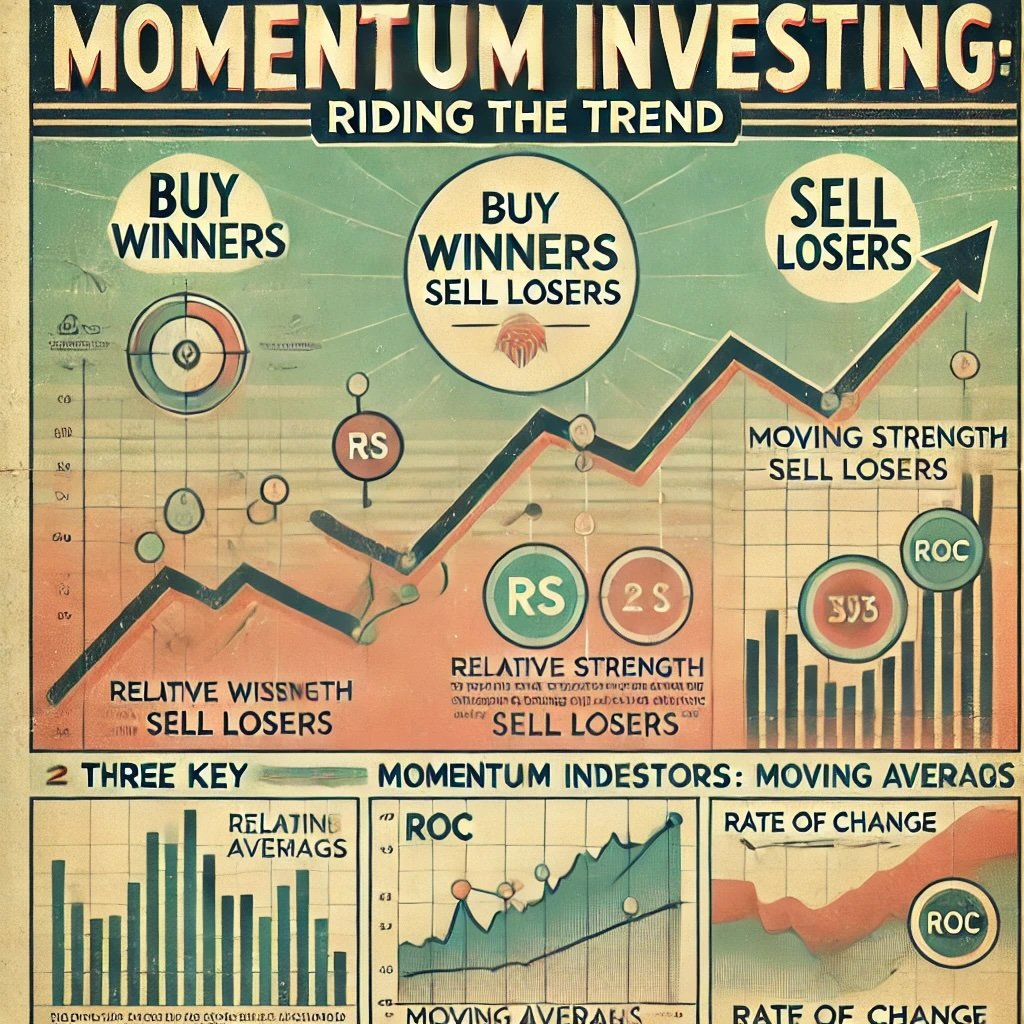In the vast domain of equity investing, strategies often come labeled and siloed. Many investors pledge allegiance to value principles, hunting for bargains the market has seemingly mispriced or abandoned. Others swear by momentum, looking strictly at recent winners in the belief that strong performance begets continued outperformance—at least for a while. But markets rarely adhere neatly to single-factor narratives. Stocks sometimes remain undervalued for painful stretches, testing the patience of value devotees. Momentum can abruptly reverse, leaving trend-chasers holding the bag.

Yet, in the kaleidoscopic world of modern finance, savvy practitioners have discovered that blending these approaches can yield a more balanced, and sometimes more potent, style. That blend, commonly called Value Momentum, marries the fundamental security of undervalued stocks with the dynamic confirmation of upward price action.
Value Momentum unites two disparate schools of thought.

Why Investors Should Care About Value Momentum
The synergy in Value Momentum is compelling because it attempts to mitigate the pitfalls inherent in one-dimensional approaches. Traditional value investing can produce lackluster returns if the broader market overlooks a cheap stock for years, or if that stock is cheap due to a legitimate structural decline. Meanwhile, pure momentum strategies risk riding ephemeral waves or hype cycles and might lead you to buy into extremely expensive names that collapse at the first sign of trouble. By demanding that a stock be both fundamentally undervalued and currently moving upward, the Value Momentum approach sets two distinct hurdles for each pick:
- Is it cheap enough or fundamentally attractive enough to avoid paying an excessive price?
- Is it demonstrating a tangible upward trend or positive relative strength that indicates market recognition?
If the answer is yes to both, the strategy believes you have a better chance of finding a stock that not only has intrinsic reasons to appreciate, but also the short-term technical momentum to keep pushing it higher. It effectively weeds out “value traps” (cheap stocks lacking catalysts) and “momentum darlings” with no fundamental support.
Two filters, fewer false positives.

Historical Perspective
Factor investing has existed for decades, with “value” and “momentum” recognized as two of the most prominent market anomalies. Academic research, from Fama-French to Asness and beyond, has consistently found a premium for value and for momentum in equity markets globally. Over time, some quants realized that combining these factors—rather than focusing on each in isolation—often leads to more stable performance, as the two styles can sometimes be negatively correlated or at least not perfectly correlated in different market regimes. Large institutional funds often integrate multi-factor models, layering in elements like quality or size. But for many individual investors and smaller funds, the concept of simply pairing value with momentum can be a simpler, more accessible approach than building elaborate multi-factor equations.
Academics and quants have been onto this for years.
Investors in every corner of the market—from small-time personal traders to large mutual funds—have found it challenging to consistently beat market indices. Yet, certain approaches, especially multi-factor strategies like Value Momentum, have demonstrated robust historical performance if executed with discipline. Let’s first dissect each of the two pillars, Value and Momentum, to ensure clarity on the foundations we’re melding.
We begin by revisiting the basics.

Understanding Value and Momentum Strategies
Value Investing: Cornerstone of Fundamentals
Value investing is among the oldest recognized styles in the stock market, championed by pioneers such as Benjamin Graham (often called the father of value investing) and later by Warren Buffett. At its core, value investing thrives on the principle that markets can incorrectly price companies in the short run due to behavioral biases, cyclical slumps, or macro distortions. Over the long run, though, a company’s share price typically converges toward its true worth, driven by actual earnings, cash flows, and net assets.
It’s about buying $1 for 50 cents.
Key Value Metrics
- Price-to-Earnings (P/E): Perhaps the most famous measure, which compares a stock’s market price to its per-share earnings. A lower ratio suggests undervaluation—though a stock might be “cheap” for a reason, such as negative growth prospects.
- Price-to-Book (P/B): Compares share price to the accounting book value (assets minus liabilities). Some cyclical or old-economy companies can carry extremely low P/B values, reflecting either a market oversight or deeper structural issues.
- Discounted Cash Flow (DCF): A more intricate approach that sums the present value of future cash flows. While robust, it’s sensitive to assumptions about growth rates and discount factors.
- Dividend Yield: Some value hunters also gravitate to companies with stable or growing dividends relative to share price, inferring that the market might be undervaluing a consistent income stream.
Advantages: The biggest benefit is a margin of safety if the stock genuinely trades below fair value. Over time, if the company’s fundamentals remain solid or improve, re-rating can lead to above-average returns. Value investing also resonates with contrarian thinkers who prefer stepping into unloved segments of the market.
Drawbacks: The biggest frustration is the potential for value traps. If the business fundamentals are deteriorating, the stock might remain cheap or get cheaper. Additionally, the timing can be uncertain, as the market might not recognize the stock’s “true worth” quickly, causing the investor to tie up capital for extended periods with little or no return.

Momentum Investing: Riding the Trend
Momentum investing rests on the idea that stocks trending upward (over a given timeframe, perhaps 3 to 12 months) tend to keep climbing, while those trending downward continue to languish. The concept, though seemingly contradictory to the efficient market hypothesis, finds support in behavioral finance—people chase winners, and the slow assimilation of new information can cause trends to persist.
Buy winners, sell losers.
Key Momentum Indicators
- Relative Strength (RS): Ranking stocks by their performance over a recent period, say 6 months, then buying the top quintile.
- Moving Averages: Checking if a stock is trading above its 50-day, 100-day, or 200-day average. If it’s consistently above, that’s a bullish momentum sign.
- Rate of Change (RoC): Gauging the speed of a stock’s rise or fall. A strong positive RoC can confirm a powerful uptrend.
Advantages: Momentum can yield impressive gains quickly, especially in bullish markets or when new catalysts spark ongoing re-ratings. It also provides a more dynamic approach—rather than waiting for fundamental revaluations, momentum traders see “the market is buying this stock, let’s join.”
Drawbacks: Overpaying is a real hazard. A stock that soared might be pricey. If sentiment shifts or a negative surprise hits, those gains can evaporate. Momentum also tends to require frequent portfolio turnover, incurring costs.
Momentum is swift but can be precarious.
Strengths and Weaknesses Summarized
- Value: Safer “fundamental” floor, but uncertain timing and risk of “cheap for a reason.”
- Momentum: Quick potential returns, but can chase ephemeral hype or suffer abrupt reversals.
When markets diverge—for instance, in a growth mania—value picks might languish. Conversely, when markets pivot to risk-off or revert to fundamentals, pure momentum players might get burned. Thus, the synergy approach can better weather these shifts by focusing on stocks that are both relatively cheap and displaying upward price traction.
Hence the impetus for synergy.

The Case for Combining Value and Momentum
Why Value Alone May Not Be Enough
Many a value investor has faced the dreaded “value trap.” Suppose a stock’s price-to-earnings ratio sits at 5, far below the market’s average of 15, apparently a screaming bargain. Yet, if that company’s fundamentals are in secular decline—maybe it sells outdated technology or lacks competitive advantages—there may be no reason for the market to rerate it higher. The stock might remain stuck or even slump further. Value investing, while it can produce multi-bagger successes, can also chain you to positions that do not appreciate for an extended period, stifling portfolio growth.
In addition, pure value approaches provide little guidance on the potential triggers for revaluation. The stock could be cheap for months or years if the catalyst never materializes. This indefinite holding period can tie up capital and test an investor’s patience, leading them to second-guess or exit prematurely.
Why Momentum Alone Can Falter
Momentum investing similarly has blind spots. If you merely chase performance, you risk paying steep valuations. For instance, a biotech stock might skyrocket on hype about a groundbreaking drug but trade at 100 times revenue, with limited real data on efficacy. If the hype deflates, momentum money floods out, and you’re left with a plummeting share price. Another scenario: cyclical or overbought stocks might continue to climb for a while, but the eventual correction can be vicious, eradicating gains. Momentum players might also succumb to frequent whipsaws, especially in volatile or sideways markets.
Turnover is another headache. Many momentum strategies revolve around short holding windows. That can mean high trading costs or short-term capital gains taxes, eroding net returns. Without some fundamental anchor, you might get into high-flying stocks whose stories are unsustainable, purely because they rank well in momentum screens.
Synergy Between the Two
Merging these approaches can yield a more balanced dynamic:
- Fundamental Safety Net: By verifying that a stock is undervalued, you reduce the risk of chasing overpriced, purely momentum-driven stocks that might crash if sentiment shifts. The stock’s cheapness can offer some cushion, limiting your downside if the momentum stalls.
- Timing Mechanism: Momentum addresses one of value’s biggest flaws—indeterminate time horizon. If the stock’s price is already trending up, that suggests a catalyst or growing recognition, hopefully accelerating the path to “fair value.”
- Reduced Drawdowns: Historically, value or momentum alone can face extended drawdowns. Combining them can smooth performance over time, as value picks might do better in downturns while momentum picks can flourish in strong bull markets.
- Empirical Support: Numerous studies show that multi-factor strategies—particularly Value plus Momentum—often rank among the highest risk-adjusted returns across long timeframes and multiple geographies.
Combining factors can yield synergy.
Academic and Professional Endorsement
Prominent quantitative funds—AQR, for instance—have championed multi-factor models, including the blend of value and momentum. Academic papers from Cliff Asness and others demonstrate that these factors can complement each other. While no guarantee of future success, the track record of such balanced approaches is persuasive. Indeed, factor investing thrives on the premise that certain anomalies persist due to persistent human biases and market structures. By bridging the “cheapness” factor with the “trend” factor, you simultaneously harness the inefficiency where undervalued stocks can remain overlooked unless some impetus exists.
Bottom line: If you’re intrigued by value’s safety margins but frustrated by uncertain timing, or if you love momentum’s dynamic but fear paying too much for ephemeral rallies, the synergy in Value Momentum might address those concerns.

Building a Value Momentum Strategy
Bringing the synergy of Value Momentum into a concrete methodology demands structure. You need to identify which value metrics to rely on, how to measure momentum, how to balance the two, and how to craft a portfolio that aligns with your risk tolerance and investment horizon. Below is a step-by-step guide.
Let’s get practical.
Screening for Value Stocks
- Choosing Your Metrics:
- P/E Ratio: A standard approach. You might filter for stocks in the bottom 30% of the S&P 500 by P/E.
- P/B Ratio: Often relevant for financials or asset-heavy industries.
- EV/EBITDA: More nuanced, factoring in enterprise value and cash flow measures.
- Free Cash Flow Yield: Some prefer this to profit metrics, as free cash flow can better reveal true profitability.
- Sector Normalization:
- Because different sectors carry distinct average ratios, you might standardize metrics within each sector. For instance, a bank might normally trade at a lower P/B than a tech firm. Adjust so you’re picking the “cheapest” 20% or 30% within each sector, preventing an overconcentration in specific industries known for always having low multiples (like cyclical materials or utilities).
- Quality Checks:
- To reduce the risk of value traps, incorporate a few quality indicators: stable or growing revenues, decent ROE, manageable debt. This minimal layer helps weed out companies that look cheap but are deteriorating fundamentally.
At this stage, your process might yield a watchlist of 100–200 stocks if you’re scanning a large universe (like all listed U.S. equities).
Momentum Indicators to Watch
Now that you have a pool of value candidates, you want to see which are actually attracting buyers. Typical momentum signals:
- Relative Strength (RS): Score each stock by its price performance over, say, the last 6 or 12 months. Stocks ranking in the top percentile—maybe the top 20% among your watchlist—meet your momentum threshold.
- Absolute vs. Market: You can also compare each stock’s performance to the broader index. If it’s beating the S&P 500 by a certain margin, that’s a sign of strong relative performance.
- Short-Term Confirmations: Some use a 1-month or 3-month track as an additional filter, ensuring the momentum is not stale or reversing.
Why Not Just 1 or 2 months? Because short timeframes can produce whipsaws. Most momentum research suggests a 6- to 12-month horizon is robust, though some strategies incorporate multiple windows. If the 1-month performance conflicts with 6-month performance, you might weigh them differently or skip that stock to avoid conflicting signals.
Combining Scores
You might assign each stock a value score (based on how cheap it is relative to peers) and a momentum score (based on 6- or 12-month returns). Then you combine them—maybe half weight to value, half to momentum. Next, rank all stocks by their combined final score. The top 20 or 30 might become your picks, subject to risk constraints.
Quantify and rank.
Sector and Market Considerations
- Diversification: While you let the screen do its job, it’s wise to ensure you’re not 60% in energy or 70% in small-caps. Setting sector or market-cap constraints helps reduce extreme concentration risk.
- Cyclical Sensitivity: Keep in mind that some sectors exhibit more cyclical behavior. If your screen is pulling in many cyclical plays at once, it might be because the cycle turned favorable. That’s fine if your data is correct, but be prepared for bigger drawdowns if macro conditions reverse.
- Liquidity: You might exclude micro-cap or illiquid names, or at least limit them, to ensure you can actually buy and sell effectively without large bid-ask spreads or slippage.
Portfolio Construction and Sizing
Number of Stocks: Depending on your approach, anywhere from 10 to 50 stocks might fit. A more concentrated approach can yield bigger returns if correct, but also bigger drawdowns if wrong. A broad approach (like 50 stocks) evens out variance but dilutes the impact of each big winner.
Position Sizing: You could equally weight each pick or tilt weighting toward higher combined scores. Alternatively, you might factor in volatility, giving smaller allocations to more volatile stocks to maintain risk parity.
Rebalancing Frequency: Value metrics shift slowly, while momentum can shift quickly. Some strategies rebalance monthly or quarterly. Overly frequent rebalancing can lead to higher turnover and costs, so balancing is key. Many quant approaches pick a monthly or quarterly schedule: updating the screen, dropping the worst offenders, and adding new top-ranked names.
Backtesting
Before committing capital, thorough backtesting is vital. You gather historical data, apply the screens, simulate monthly or quarterly rebalances, track performance net of transaction costs, and observe how the approach fares in bull, bear, and sideways markets. Beware of data-snooping or curve-fitting. The simpler your approach—like a single value ratio plus momentum—the less likely you are to overfit.
Stress Testing: Evaluate how the strategy performed during major crises (e.g., 2008 financial crisis, 2020 pandemic meltdown). Did the combination help avoid huge drawdowns, or did it still see big losses?
Execution Details
Implementation might be done via:
- Direct Stock Ownership: Placing orders for 10 to 50 different equities.
- Partial or Thematic Baskets: If you’re an institutional manager, you might use advanced order types or direct market access.
- Possible Option Overlays: Some advanced users might hedge with index options or write covered calls. But for pure Value Momentum, typically straightforward equity positions suffice.
Capital Controls: Ensure you have a risk management plan. Even the best multi-factor approach can face months of underperformance. A broad market meltdown can cause your picks to drop in price, albeit hopefully less or for shorter durations if your approach works as intended.
Set up the method, test it, refine it.

Real-World Examples and Case Studies
Real-world markets can be messy, but they often confirm that multi-factor strategies—like Value Momentum—pack a punch. Below, we examine a few hypothetical or historically inspired scenarios that show how combining these approaches can produce outsized gains, as well as scenarios revealing pitfalls or missed opportunities.
Learning from experience.
Example 1: Tech Stock Transitioning from Undervalued to Fast-Growing
Imagine a mid-cap tech firm that spent years overshadowed by bigger, flashier competitors. Perhaps it had decent cash flows, stable if unspectacular growth, and thus traded at a P/E of 10 while the broader market soared at multiples of 20 or more. A new product release or pivot catalyzed fresh investor interest, lifting the stock from $40 to $50 in a matter of weeks. By fundamental metrics, even at $50, it remained undervalued with a P/E of around 12 compared to peers at 25+. That’s the value dimension. Meanwhile, the 3- and 6-month relative strength soared, meaning a momentum screen would pick it up as a stock outrunning the market.
Outcome: A Value Momentum investor spots it in their monthly re-screen, invests around $50. Over the next quarter, more analysts upgrade the stock as the product gains traction. The share price hits $70, netting a handsome profit. If you only used value, you might’ve bought earlier at $40 but also might have sold too soon if you doubted the new product. If you only used momentum, you might have avoided it earlier due to lack of hype. The synergy approach captures the moment after momentum emerges but while fundamental valuations remain supportive.
Example 2: Energy Sector Rebound from a Prolonged Slump
Energy stocks often languish for extended periods following a commodity price crash, pushing them into “value territory.” However, they can remain depressed if oil and gas prices stay low. Suppose an integrated oil company’s stock trades near multi-year lows, with a P/E ratio half that of the overall market. Its momentum remained negative or neutral for months. Then, an OPEC decision or a supply disruption triggers a moderate oil price rally. Over the next 3 months, that battered stock’s share price climbs steadily, crossing key moving averages and posting strong relative returns. Suddenly, momentum indicators turn positive. A Value Momentum screen identifies it as among the top undervalued and upward-moving picks.
Outcome: The share price surges further as hedge funds re-enter the sector. The synergy approach capitalizes on the discounted state plus the newly minted upward trend. Without momentum signals, a pure value investor might have entered way earlier—and endured months of pain. Without the value screen, pure momentum folks might skip it if the price movement is overshadowed by trending tech stocks. But the synergy picks it up right when fundamentals and technicals align.
Example 3: Value Trap with Fake Momentum
A consumer electronics manufacturer trades at a low P/E ratio around 8 due to declining brand relevance and stiff global competition. A minor news event about a new product line sparks a short-lived rally in the stock from $20 to $25, triggering momentum-based green lights. The value screen sees a P/E of 8, apparently “cheap,” so the synergy approach flags it. One invests at $25. However, the product line fails to gain traction, and in the next earnings release, the management reveals falling margins. The stock collapses to $15. Despite combined signals, the synergy approach was blindsided by ephemeral or false momentum, and the fundamental “value” portion turned out to be a trap with no real catalyst for improvement.
Lesson: The synergy approach can help, but it’s not foolproof. Additional checks—like verifying the stability of the company’s fundamentals or waiting for more consistent momentum—could reduce such fiascos.
Case Study: Historical 2009–2012 Recovery Period
Post the 2008 financial crisis meltdown, many banks and cyclicals were battered. By late 2009, certain bank stocks traded far below book value, indicating “deep value.” Meanwhile, from mid-2009 onward, the broader market was rebounding, pulling these stocks upward. A synergy approach that recognized strong 3-to-6-month price momentum layered on top of extremely low valuations might have pinpointed specific banks or industrials that soared from 2010 to 2012 as the economy recovered. Contrarily, a purely momentum approach might have been reluctant to wade into the battered financial sector so soon after the crisis, while pure value might have caught them earlier but endured more volatility. The synergy approach enters once momentum is clear but valuations remain compelling, thus capturing a big chunk of the recovery surge.
Recovery phases can reward synergy.
Takeaways from Examples
- Catalyst Importance: If the synergy approach lacks a real fundamental catalyst, a stock’s upward price flicker might fizzle. Checking for news or structural changes helps confirm genuine momentum.
- Sector Timing: Some of the best synergy plays happen when entire sectors shift from oversold to trending upward, such as cyclical rebounds or post-crisis transitions.
- Risk Monitoring: Even synergy can fail under severe macro shocks or if underlying fundamentals degrade. Diversify, keep position sizes moderate, and watch for extended negative shifts in momentum.
From these examples, we glean that while Value Momentum can produce strong, often better results than single-factor methods, it requires vigilance. Not every “cheap + up” combination is a guaranteed winner.

Conclusion
Value Momentum is not simply a theoretical fancy or a fleeting market fad. It stands as a serious, data-backed approach that merges the bedrock of undervalued stocks with the forward energy of positive price trends. By layering fundamental “cheapness” filters onto momentum signals, you tighten your selection process, effectively seeking companies that both appear mispriced in the market’s eyes and are already winning the race of market sentiment. Yet, as we’ve detailed, no strategy is infallible. Value traps can masquerade as bargains with ephemeral momentum, while real black-swan events can slam any approach.
It’s an approach, not a magic formula.
Recap of Value Momentum
- Core Principle: Choose companies that rank well on both a value metric (like low P/E or strong free cash flow yield) and a momentum metric (like top quartile relative performance or upward trend lines).
- Why It Works: Value ensures you don’t pay too much, while momentum ensures the market is actually re-rating the stock. This can circumvent the indefinite waiting typical of pure value picks or the bubble-chasing tendencies of pure momentum.
- Implementation Steps:
- Screen for undervalued stocks.
- Filter further by relative strength or price performance over a chosen timeframe.
- Manage portfolio size, sector exposures, and rebalancing intervals.
- Watch out for changes in fundamentals or momentum signals.
Key Takeaways for Investors
- Balanced Factor Strategy: Combining two robust factors can mitigate the weaknesses that each factor exhibits alone. Historical data often supports better risk-adjusted returns from multi-factor blends.
- Practical Execution: Keep the method simple enough to avoid overfitting. A single or small set of value metrics plus a well-chosen momentum window can suffice. Overcomplication might hamper transparency or lead to curve-fitting.
- Risks Remain: Value Momentum doesn’t provide immunity to market downturns, sector collapses, or abrupt sentiment reversals. Proper position sizing and watchful rebalancing remain paramount.
- Patience Plus Timing: A synergy approach still requires discipline in letting winners run and cutting losers early if momentum fades or fundamentals break down.
Discipline and systematic management are crucial.
Who Benefits from Value Momentum?
Investors who:
- Seek a higher-octane approach than pure value but want more fundamental solidity than raw momentum.
- Appreciate the logic of factor investing and are willing to handle moderate portfolio turnover for potential alpha.
- Are comfortable with occasional underperformance if the entire market penalizes value or if momentum stalls for a season.
Traders or active portfolio managers might find it especially appealing if they’re scanning broad equity universes, running periodic rebalances, and applying systematic screens. The essential element is a willingness to methodically apply rules while trusting the data-driven nature of factor synergy.
Final Thoughts
Value Momentum captures the essence of bridging fundamental logic (buy cheap, strong companies) with the dynamic impetus of the market (stocks already climbing). It counters the main shortcoming of each approach, hopefully leading to a more stable, high-return portfolio than either alone might deliver. However, success ultimately hinges on discipline, proper research, and risk management. Tools like sector caps, robust quality filters, or partial hedging can further enhance the strategy’s resilience.
For those ready to step beyond standard value or momentum investing, exploring Value Momentum can be a revelation. It’s not a magic bullet—there is no such thing in finance—but it stands as a well-grounded style with encouraging historical and theoretical underpinnings. In a world where single-style investing often falters under shifting market dynamics, adopting a multi-factor synergy can empower you to adapt, endure, and seize opportunities across different phases of the market cycle.
Important Information
Comprehensive Investment Disclaimer:
All content provided on this website (including but not limited to portfolio ideas, fund analyses, investment strategies, commentary on market conditions, and discussions regarding leverage) is strictly for educational, informational, and illustrative purposes only. The information does not constitute financial, investment, tax, accounting, or legal advice. Opinions, strategies, and ideas presented herein represent personal perspectives, are based on independent research and publicly available information, and do not necessarily reflect the views or official positions of any third-party organizations, institutions, or affiliates.
Investing in financial markets inherently carries substantial risks, including but not limited to market volatility, economic uncertainties, geopolitical developments, and liquidity risks. You must be fully aware that there is always the potential for partial or total loss of your principal investment. Additionally, the use of leverage or leveraged financial products significantly increases risk exposure by amplifying both potential gains and potential losses, and thus is not appropriate or advisable for all investors. Using leverage may result in losing more than your initial invested capital, incurring margin calls, experiencing substantial interest costs, or suffering severe financial distress.
Past performance indicators, including historical data, backtesting results, and hypothetical scenarios, should never be viewed as guarantees or reliable predictions of future performance. Any examples provided are purely hypothetical and intended only for illustration purposes. Performance benchmarks, such as market indexes mentioned on this site, are theoretical and are not directly investable. While diligent efforts are made to provide accurate and current information, “Picture Perfect Portfolios” does not warrant, represent, or guarantee the accuracy, completeness, or timeliness of any information provided. Errors, inaccuracies, or outdated information may exist.
Users of this website are strongly encouraged to independently verify all information, conduct comprehensive research and due diligence, and engage with qualified financial, investment, tax, or legal professionals before making any investment or financial decisions. The responsibility for making informed investment decisions rests entirely with the individual. “Picture Perfect Portfolios” explicitly disclaims all liability for any direct, indirect, incidental, special, consequential, or other losses or damages incurred, financial or otherwise, arising out of reliance upon, or use of, any content or information presented on this website.
By accessing, reading, and utilizing the content on this website, you expressly acknowledge, understand, accept, and agree to abide by these terms and conditions. Please consult the full and detailed disclaimer available elsewhere on this website for further clarification and additional important disclosures. Read the complete disclaimer here.




